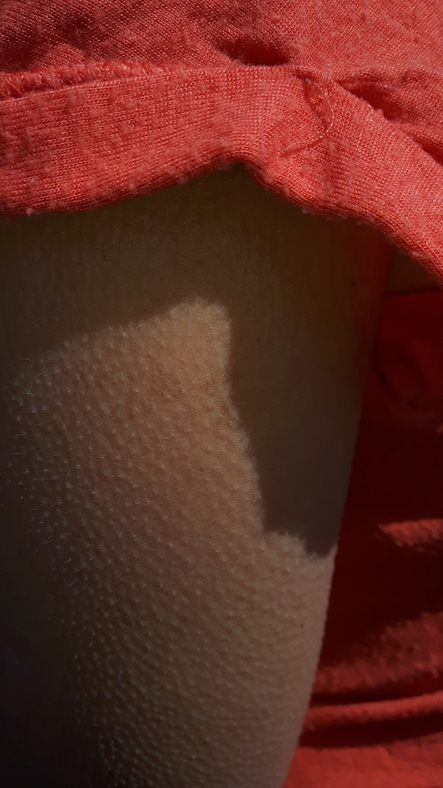
They go by different names: goosebumps, goose pimples, goose flesh, and my personal favorite, goose bumples. The medical term is cutis anserine (cutis means skin and anser means goose). I guess the similarity in texture is just too close to goose skin to ignore. Other medical terms for goosebumps are horripilation, piloerection, or the pilomotor reflex.
Each of these terms describes a temporary change in the skin from smooth to bumpy, most commonly developing after exposure to cold.
Many people associate goosebumps with fear, or perhaps more accurately, with horror. Perhaps that’s why a popular series of children’s horror stories by R.L. Stine published in the 1990s was called Goosebumps.
Ever wonder why you get them? Do they serve a purpose? Why do they develop when we’re frightened?
What are goosebumps?
Goosebumps are the result of tiny muscles flexing in the skin, making hair follicles rise up a bit. This causes hairs to stand up. Goosebumps are an involuntary reaction: nerves from the sympathetic nervous system — the nerves that control the fight or flight response — control these skin muscles.
In the animal kingdom, a threatened animal has a similar reaction, causing fur to be puffed out a bit. This makes the animal appear bigger and more dangerous. Perhaps the most dramatic example is the porcupine, which puffs out its quills when sensing danger. This can make a threatening adversary think twice before attacking. That may explain why the sympathetic nervous system controls goosebumps — the reflex is tied into the fight or flight response.
This just in
Researchers studying mice recently linked goosebumps to the regeneration of hair and hair follicles. It seems that the nerves connected to the tiny muscles responsible for goosebumps also connect to hair follicle stem cells, which are the cells responsible for hair growth. So, in response to cold, the nerve tells the tiny muscles in the skin to contract (causing goosebumps) and the same nerve activates hair follicle stem cells for new hair growth.
What purpose do goosebumps serve?
Goosebumps may help you conserve heat when you’re exposed to cold. They may do this in several ways.
- As with larger muscles, contraction of the muscles in the skin (called arrectores pilorum) generates heat.
- The raised hair follicles cause skin pores to close.
- Hairs standing up trap a layer of air near the skin, holding onto body heat.
Each of these might be more important for furry animals than for humans. In fact, it’s not clear how important goosebumps are in humans. For example, if you couldn’t form goosebumps at all, it wouldn’t necessarily mean that you’d have problems with temperature control. Goosebumps may be one of those leftovers from our evolutionary ancestors (like the coccyx, or tailbone) that serve no important purpose.
The new discovery linking goosebumps with hair follicle stem cells might be explained as a longer-term response to cold, at least for animals with fur: they get goosebumps (or the animal equivalent) in the short run to conserve heat, and thicker fur to keep warmer in the long term.
Goosebumps: More than just being cold
Most people associate goosebumps with unpleasant situations, such as feeling particularly cold or feeling afraid. Yet there is more to it than that. The arrectores pilorum are hooked up to the sympathetic nervous system, and the sympathetic nervous system has input from many parts of the brain, including those involved with motivation, arousal, and emotion. So other stimuli may cause goosebumps, for instance:
- hearing music or seeing art that is particularly moving or completely engrosses you (which is why you might say “it gave me chills”)
- awe
- pride
- excitement
- fear.
Goosebumps and disease
Though rare, goosebumps can be a sign of a seizure disorder called temporal lobe epilepsy, a disorder of the sympathetic nervous system, or other brain disorders. They are also common during heroin or other opiate withdrawal. In fact, one explanation for the origin of the expression “quitting cold turkey” is that goose bumps that develop during withdrawal from heroin mimic cold turkey flesh.
The bottom line
You’ll see goosebumps most often when you’re cold. But don’t be surprised (or afraid or awed) if they appear at other times. They are a universal but poorly understood phenomenon, but our understanding is improving. And the recent discovery linking goosebumps with hair follicle regeneration could lead to more than just a better understanding of goosebumps; it could lead to new ways to fight baldness or improve tissue healing.
In humans, it’s possible that goosebumps will gradually disappear over the coming centuries as with other remnants of evolution, like the tailbone or wisdom teeth. Or they may serve a more important role than we currently understand and continue to puzzle us for years to come.
